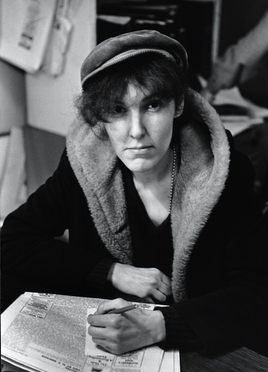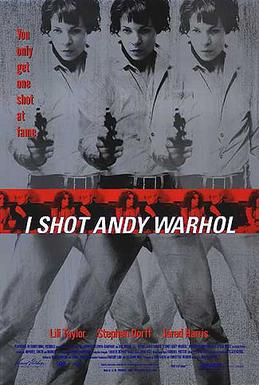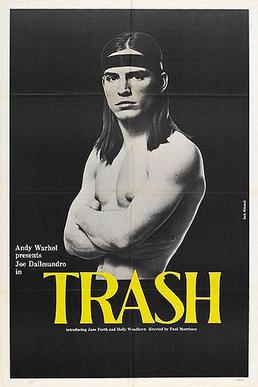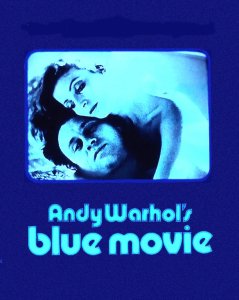Related Research Articles

Andy Warhol was an American visual artist, film director, producer, and leading figure in the pop art movement. His works explore the relationship between artistic expression, advertising, and celebrity culture that flourished by the 1960s, and span a variety of media, including painting, silkscreening, photography, film, and sculpture. Some of his best-known works include the silkscreen paintings Campbell's Soup Cans (1962) and Marilyn Diptych (1962), the experimental films Empire (1964) and Chelsea Girls (1966), and the multimedia events known as the Exploding Plastic Inevitable (1966–67).

Valerie Jean Solanas was an American radical feminist known for the SCUM Manifesto, which she self-published in 1967, and for her attempt to murder artist Andy Warhol in 1968.
Radley Metzger was an American pioneering filmmaker and film distributor, most noted for popular artistic, adult-oriented films, including Thérèse and Isabelle (1968), Camille 2000 (1969), The Lickerish Quartet (1970), Score (1974), The Private Afternoons of Pamela Mann (1974), The Image (1975), The Opening of Misty Beethoven (1976) and Barbara Broadcast (1977). According to one film reviewer, Metzger's films, including those made during the Golden Age of Porn (1969–1984), are noted for their "lavish design, witty screenplays, and a penchant for the unusual camera angle". Another reviewer noted that his films were "highly artistic — and often cerebral ... and often featured gorgeous cinematography". Film and audio works by Metzger have been added to the permanent collection of the Museum of Modern Art (MoMA) in New York City.

I Shot Andy Warhol is a 1996 biographical drama film about the life of Valerie Solanas and her relationship with the artist Andy Warhol. The film marked the feature film directorial debut of Canadian director Mary Harron. The film stars Lili Taylor as Valerie, Jared Harris as Andy Warhol, and Martha Plimpton as Valerie's friend Stevie. Stephen Dorff plays Warhol superstar Candy Darling. John Cale of The Velvet Underground wrote the film's score despite protests from former band member Lou Reed. Yo La Tengo plays an anonymous band that is somewhat reminiscent of the group.
Warhol superstars were a clique of New York City personalities promoted by the pop artist Andy Warhol during the 1960s and early 1970s. These personalities appeared in Warhol's artworks and accompanied him in his social life, epitomizing his dictum, "In the future everyone will be famous for fifteen minutes". Warhol would simply film them, and declare them "superstars".

The Factory was Andy Warhol's studio in New York City, which had four locations between 1963 and 1987. The Factory became famed for its parties in the 1960s. It was the hip hangout spot for artists, musicians, celebrities and Warhol's superstars. The original Factory was often referred to as the Silver Factory. In the studio, Warhol's workers would make silkscreens and lithographs under his direction.

Chelsea Girl is the debut solo album and second studio album by German singer Nico. It was released in October 1967 by Verve Records and was recorded following Nico's collaboration with the Velvet Underground on their 1967 debut studio album. It was produced by Tom Wilson, who added string and flute arrangements against the wishes of Nico. The title is a reference to Andy Warhol's 1966 film Chelsea Girls, in which Nico starred.

Factory Girl is a 2006 American biographical film directed by George Hickenlooper. It is based on the rapid rise and fall of 1960s underground film star and socialite Edie Sedgwick, known for her association with the artist Andy Warhol.

Trash is a 1970 American drama film directed and written by Paul Morrissey and starring Joe Dallesandro, Holly Woodlawn and Jane Forth. Dallesandro had previously starred in several other Andy Warhol/Paul Morrissey films such as The Loves of Ondine, Lonesome Cowboys, San Diego Surf, and Flesh.
Viva is an American actress, writer and former Warhol superstar.

Blue Movie is a 1969 American erotic film written, produced and directed by Andy Warhol. It is the first adult erotic film depicting explicit sex to receive wide theatrical release in the United States, and is regarded as a seminal film in the Golden Age of Porn (1969–1984), which, before the legalization of pornography in Denmark on July 1, 1969, started on June 12, 1969 with the release of Blue Movie at the Elgin Theater, and later, the New Andy Warhol Garrick Theatre, in New York City. Blue Movie helped inaugurate the "porno chic" phenomenon, in which porn was publicly discussed by celebrities and taken seriously by film critics, in modern American culture, and shortly thereafter, in many other countries throughout the world. According to Warhol, Blue Movie was a major influence in the making of Last Tango in Paris, an internationally controversial erotic drama film starring Marlon Brando and released a few years after Blue Movie was made. Viva and Louis Waldon, playing themselves, starred in Blue Movie.

Lonesome Cowboys is a 1968 American Western film directed by Andy Warhol and written and produced by Paul Morrissey. The film is a satire of Hollywood Westerns, and was initially screened in November 1968 at the San Francisco International Film Festival, where it won the Best Film Award. On May 5, 1969, it was shown for initial viewings at the New Andy Warhol Garrick Theatre in New York City.

Chelsea Girls is a 1966 American experimental underground film directed by Andy Warhol and Paul Morrissey. The film was Warhol's first major commercial success after a long line of avant-garde art films. It was shot at the Hotel Chelsea and other locations in New York City, and follows the lives of several of the young women living there, and stars many of Warhol's superstars. The film is presented in a split screen, accompanied by alternating soundtracks attached to each scene and an alternation between black-and-white and color photography. The original cut runs at just over three hours long.
Tom Baker was an American actor who starred in the Andy Warhol film I, a Man (1967). He was a close friend of Jim Morrison of The Doors.

Isabelle Collin Dufresne, known professionally as Ultra Violet, was a French-American artist, author, and both a colleague of Andy Warhol and one of his so-called Superstars. Earlier in her career, she worked for and studied with surrealist artist Salvador Dalí. Dufresne lived and worked in New York City, and also had a studio in Nice, France.

The term "Golden Age of Porn", or "porno chic", refers to a 15-year period (1969–1984) in commercial American pornography, in which sexually explicit films experienced positive attention from mainstream cinemas, movie critics, and the general public. This American period, which had subsequently spread internationally, and that began before the legalization of pornography in Denmark on July 1, 1969, started on June 12, 1969, with the theatrical release of the film Blue Movie directed by Andy Warhol, and, somewhat later, with the release of the 1970 film Mona produced by Bill Osco. These films were the first adult erotic films depicting explicit sex to receive wide theatrical release in the United States. Both influenced the making of films such as 1972's Deep Throat starring Linda Lovelace and directed by Gerard Damiano, Behind the Green Door starring Marilyn Chambers and directed by the Mitchell brothers, 1973's The Devil in Miss Jones also by Damiano, and 1976's The Opening of Misty Beethoven by Radley Metzger, the "crown jewel" of the Golden Age, according to award-winning author Toni Bentley. According to Andy Warhol, his Blue Movie film was a major influence in the making of Last Tango in Paris, an internationally controversial erotic drama film, starring Marlon Brando, and released a few years after Blue Movie was shown in theaters.
San Diego Surf is a 1968 feature film directed by Andy Warhol and Paul Morrissey, and filmed in La Jolla, California in May 1968. On June 3, 1968, Warhol was shot by Valerie Solanas, bringing work on the film to a halt. In 1996, the Andy Warhol Foundation commissioned Morrissey to "finish editing the film based on Warhol's notes".

I, a Woman is a 1965 black-and-white Danish-Swedish erotic film whose break-through popularity helped initiate a wave of sexploitation films into mainstream American theaters in the late 1960s, and inspired Andy Warhol to write and direct his feature-length experimental film version I, a Man.

The Garrick Cinema was a 199-seat movie house at 152 Bleecker Street in the Greenwich Village neighborhood of Lower Manhattan in New York City. Andy Warhol debuted many of his notable films in this building in the late 1960s. Frank Zappa and the Mothers of Invention played here nightly for 6 months in 1967.
Allen Midgette was an American actor and painter who is known for impersonating Andy Warhol on a 1968 University lecture tour after the artist was shot by Valerie Solanas. He was eventfully found out.
References
- 1 2 3 Thompson, Howard (August 25, 1967). "I a Man (1967) The Screen: Andy Warhol's 'I, a Man' at the Hudson". New York Times. p. 28. Retrieved 30 October 2014.
- ↑ Thomas, Kevin (August 9, 2001). "Sadness and Humor From Warhol". Los Angeles Times. Retrieved 30 October 2014.
- ↑ Bockris, Victor (1989). The life and death of Andy Warhol . New York: Bantam Books. p. 272. ISBN 9780553057089.
- ↑ Davis, Stephen (2004). Jim Morrison: Life, Death, Legend . Gotham Books. pp. 149–50. ISBN 9781101218273.
- ↑ Ebert, Roger (August 1, 1968). "I, A Man". Reviews. rogerebert.com. Retrieved 30 October 2014.